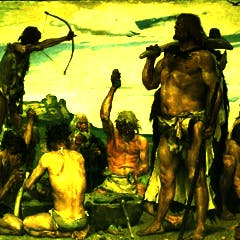
Articles on Anthropology
Displaying 21 - 40 of 228 articles

Contrary to the idea that apes evolved their upright posture to reach for fruit in the forest canopy, the earliest known ape with this stature, Morotopithecus, lived in more open grassy environments.

From Aristotle to Darwin, inaccurate and biased narratives in science not only reproduce these biases in future generations but also perpetuate the discrimination they are used to justify.

The first ancient DNA sequences from peoples of the medieval Swahili civilization push aside colonialist stories and reveal genetic connections from the past.

Trauma can affect how people remember and describe experiences. Many survivors express their pain through objects and physical symptoms, an anthropologist explains.

Men in rural China spend more time in leisure or social activities, or just hanging around and resting.

If you skirt the small talk and dig a little deeper, you’ll be surprised at what you might learn.

Conservation that places less emphasis on who may or may not use a piece of land could result in better outcomes for people and wildlife.

Anthropologist Neville White has spent two months a year since 1974 in Arnhem Land, as a guest of Yolngu families residing at the Donydji community.

When, how, where and why did complex hierarchical societies evolve? Understanding how we got to this point in time may help us address global challenges, like climate change.

Animism describes religions in which humans are connected to the landscape around them but do not dominate it.

Thousands of ancient genomes have been sequenced to date. A Nobel Prize highlights tremendous opportunities for aDNA, as well as challenges related to rapid growth, equity and misinformation.

Not all human societies throughout history have been patriarchal.

Norman Daly’s 1972 exhibition, ‘The Civilization of Llhuros,’ presented fiction as fact – and reminded viewers of just how easily they could be duped.

Our ancient ancestors didn’t have clothes or houses – but that constant exposure to the sun helped their skin protect itself from the worst sun damage.

An anthropologist explains how years of conflict have made Ukrainians reassess their priorities and relationships.

Nasty, brutish – but not necessarily short. Here’s how archaeologists know plenty of people didn’t die young.

As material objects, diaries give scholars an intimate look into their subjects’ lives, including handwriting and mementos. What if diaries in the future are nothing but insubstantial digital ghosts?

The fundamental issue at stake in abortion debates is personhood, which is viewed differently around the world, an anthropologist writes.

The DIALOG network forms a bridge between scientific and Indigenous knowledge. It renews the relationship between the university and the Indigenous world, which has for too long been one-sided.

Perhaps what is most interesting about #Swedengate is not what it tells us about Sweden, but what it tells us about ourselves.
